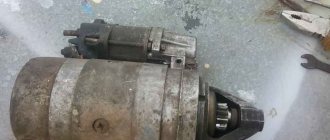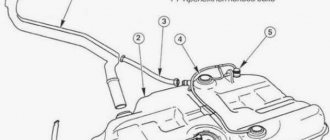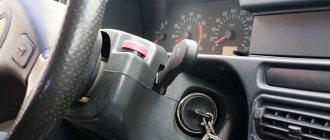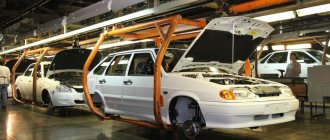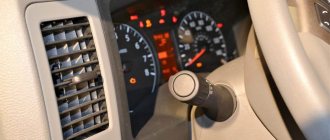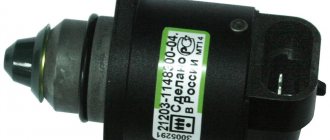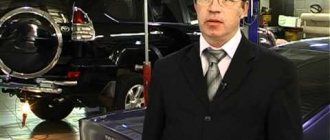If the engine stalls when you press the clutch, this may be due to various reasons. Starting from the breakdown of sensors and ending with the incorrect operation of the main components and assemblies of the machine. We will talk about solving these problems in this article.
Most common reasons
Cleaning the throttle valve
Replacing the idle speed sensor
Changing the fuel filter
Video “Guide to Replacing the Fuel Filter”
Comments and Reviews
Most common reasons
First, let’s look at why, when you press the clutch pedal or when braking, the car’s injection system malfunctions and the engine stalls:
- Failure of the idle speed controller. If the car stalls when you press the pedal, you need to diagnose this sensor. This can happen both while driving and at the beginning of the movement. When the driver increases idle speed by pressing the gas, the engine recovers and continues to function. But if the power of the power unit does not increase, the engine stalls again. To solve the problem, you need to check the functionality of the controller, the integrity of the electrical circuit, and also clean the contacts on the connector. If this does not help, the sensor must be replaced.
- Malfunction in the throttle assembly. When you push in the clutch and brake, a clogged throttle body can cause the engine to stall. This unit in a vehicle is used to regulate the volume of the air-fuel mixture that is formed in the engine. Due to poor quality gasoline and other factors, the valve sometimes becomes clogged. To avoid problems when the internal combustion engine stalls when the clutch is depressed, it is recommended to use only high-quality fuel. The only solution to the problem is to clean the damper. If the unit is worn out and cannot perform its functions even when cleaned, it must be replaced.
- A problem occurs when the driver presses the clutch pedal to change speed or presses it while braking, the engine begins to “trouble” and eventually stops. The malfunction is often associated with a failure of the throttle position controller. If cleaning the damper does not help solve the problem, you need to diagnose the sensor. Most manufacturers do not regulate the replacement of this device, since the controller is installed for the entire service life of the vehicle. But the sensor can fail and lead to the problem of spontaneous shutdown of the power unit. It is necessary to diagnose the controller, check the integrity of the contacts on the connector and the wiring. If these elements are intact and cleaning the plug does not help, the device must be replaced.
- Malfunction of the fuel filter device. When the filter's service life comes to an end, it begins to work incorrectly. Often its malfunction is associated with the regular use of low-quality fuel. If the filter becomes clogged, the speed drops, and the car may stall not only when the clutch is depressed, but also when driving in gear. Cleaning the device may solve the problem, but not for long. It's better to change it.
- Malfunction of the fuel pump. If the device breaks down, it will be impossible to start the car engine. But if the pump does not work correctly, but still performs its functions, then the engine will periodically stall. Malfunctions in its operation occur as a result of the constant use of low-quality fuel. To solve the problem, the device is checked and repaired. If the pump is broken, it must be replaced.
- The generator device may also be causing the problem. A breakdown of this unit will result in all electrical appliances in the car being powered by the battery. If the generator set fails, the engine may stall randomly. But such a problem actually happens quite rarely.
The Mir Matizov channel in its video offers a more detailed look at the reasons for the engine stopping.
Features of car diagnostics
Drivers are regularly told that they should only get under the car if they understand it. But still there are always people who want to test their strength in this way.
It’s okay if the fault is not complex and is on the surface. But the engine is the heart of the car, in order to get to it you will have to disassemble some part of the car. Those. It is obvious that engine diagnostics itself will take more than one day.
Experienced auto mechanics use modern equipment and sensors that allow them to measure the main parameters in the operation of all three of the above systems in automatic mode.
When diagnosing an engine, the problem may be the lack of such equipment. After all, for example, it is impossible to measure the pressure on the eye; for this you only need a specialized tonometer.
When diagnosing a car like a Ford Focus 2, the on-board computer can help you. It will show in coded form why the engine did not start or stalled. Of course, the problem is not always solved so easily.
Yes, and malfunctions are displayed on the screen in encoded form and to decipher you will need to turn to the all-knowing World Wide Web.
In this article we talked about the main reasons why the engine may not start. In fact, there are many more of them; engine diagnostics are considered one of the most difficult and time-consuming. But you should not take such problems lightly, so that they do not lead to an accident in the future, leave you without “wheels” and derail your plans.
List of all car service services and prices for themDownload price list If you do not know the nature of the breakdown of your car, we will help you figure it out. Leave a request and we will contact you to resolve the problem. Submit your application
Solution
The procedure to correct the problem depends on the type of problem. If the engine stalls when you press the clutch or brake on a car with an injector, you can solve the problem yourself. Let's consider all cases of troubleshooting.
Cleaning the throttle valve
To complete the task, you will need a special cleaning agent; it can be purchased at any automotive store. There are many types of cleaners, you can choose something to suit your budget. The procedure for dismantling the unit depends on the design features of the car; it can be performed in different ways.
Throttle valve before and after cleaning
Let's consider the removal process using the Daewoo Lanos model as an example:
- Open the hood of the car and remove the damper. To do this, loosen the clamps securing the air supply hose and remove it. Disconnect the wiring connectors from the idle speed controller and throttle position control.
- Disconnect the assembly control drive cable.
- Using pliers, pull the clamps off the damper heating hoses. There is no need to disconnect the hoses. Unscrew the expansion tank cap to relieve pressure in the system, then tighten it. Dismantle the pipes one by one to prevent refrigerant leakage from the system, and close the resulting holes. This will require M10 bolts.
- Using a 12 or 13 socket wrench, depending on the size of the bolts, unscrew the parts securing the throttle device. Carefully dismantle the assembly, while trying not to damage the sealing element. Assess its condition. If necessary, the rubber band is replaced with a new one if it is very worn.
- Using a Phillips head screwdriver, remove the two bolts securing the idle speed controller to the throttle body. There is a gasket on the sensor, don't lose it.
- You can now perform rinsing. Take the purchased product and use it to clean the unit, including all channels. You can also wash the idle speed sensor. Clean the air lines, as well as the calibrated positive crankcase ventilation duct. Usually it is its contamination that leads to malfunctions in the operation of the internal combustion engine. To clean it you will need a pin or needle.
- Assemble the device and check how the power unit operates.
Replacing the idle speed sensor
Let's look at the procedure for replacing a device using a VAZ car as an example:
- Turn off the ignition and open the hood of the car. Locate the mounting location of the idle speed sensor. Disconnect the negative terminal from the battery. To find the controller, use the service book for the car.
- When the sensor is found, disconnect the wiring connector from it. The plug is usually attached to the controller using a clamp.
- Unscrew the bolts securing the device to the throttle hose. Dismantle the controller.
- Install a new device instead of the old one. The installation procedure is performed in reverse order. If there are sealing elements on the sensor, treat the rubber bands with motor fluid.
- After installation, calibrate the device. Reconnect the disconnected battery terminal and activate the ignition. There is no need to start the engine. Wait about 10 seconds, then turn off the ignition.
Character of potassium ignition
In theory, there are two types of potassium ignition, and to better understand the causes and consequences of the problem, it is necessary to consider both options. One of them is specifically used in the power plant to ignite the air-fuel mixture, the appearance of the second is characterized by a malfunction of the engine, so it is considered dangerous. To protect the unit, it is necessary to correctly identify the first signs of the onset of a harmful phenomenon.
In modern power plants, spark ignition of the air-fuel mixture is almost universally used. Periodically, combustion is accompanied by the appearance of detonation and many confuse this process with potassium ignition, although these are completely different phenomena.
Video “Guide to Replacing the Fuel Filter”
The channel In Sandro's garage, using the example of tenth generation VAZ cars, offers to familiarize yourself with the process of changing the filter device, described in the video.
During the service life, various emergency situations may arise. It's good when the problem is obvious. But it happens when one or another symptom may indicate several problems at once. Such manifestations on Ford Focus 1 include a stalling engine, for example, at idle, when moving slowly or braking. Naturally, this is a problem not only with the Focus, but with any car.
By collecting and analyzing the many years of experience of FordFocus owners, we can identify a number of problems that such a symptom may indicate. Usually it manifests itself in conjunction with the fact that the car does not start, power is lost, etc.
Incorrect starter operation on Ford Focus 2
The problems with the starter don't end there. It may not work correctly, and this is the first sign that it will soon need to be repaired. With your own hands, or with the help of a service station, you will have to find out the reasons why the starter rotates slowly. This can be heard immediately and the case may overheat. The cause may be bearings or bushings that have gotten into water or dirt, as well as misalignment of the armature due to wear of the bushings or bearings. Here, too, you cannot do without removing and disassembling the autostarter.
The next trouble may be the anchor. Overheating of the starter can cause intense wear of the bushings, as a result of which the armature can begin to short-circuit to the stator. If measures are not taken in time, the rotor or stator winding may burn out, and the cost of repair in this case can be at least 1,500 rubles - rewinding the winding is not cheap. In this case, if the autostarter is already on its last legs, then it is easier to buy a new one or a used one, but it is guaranteed to work.
Brushes can present another unpleasant surprise. There are four of them in the “self-start” Ford Focus 2. In order to get to the brush holder block, you need to remove and disassemble the starter almost completely. The brushes may simply wear out, and this will be immediately visible. This is easy to check; just measure each brush in height. The brush should protrude 5-7 mm from the body. It is also necessary to check for short circuits between the brush housings and the starter housing. This can be done with a regular multimeter; it should show that there is no contact between the brush housings and the starter housing.
We will not describe the procedure for dismantling the starter in detail, since it is described in some detail in the Ford Focus 2 user manual. Let us outline the main stages of removal:
- Remove the engine mudguard.
- Unscrew the nuts and remove the contact block from the solenoid relay.
- Unscrew the three 13mm bolts that secure the autostarter to the gearbox housing.
- Disengage the starter from the flywheel and remove it from its seat.
To assess the condition of the starter, it is enough to turn the drive gear in different directions. In one direction it should rotate with the shaft together, in the other - only the gear.
Actually, this is all we can do to save the autostarter. Almost all the parts, the armature, the solenoid relay, the contact group and the gearbox, the starter bendix for the Ford Focus 2 1.6, the price of which will be about 500 rubles, must be replaced, therefore, if you wish, you can repair the starter yourself and save several thousand, least. Happy work!
Problems that a stalling engine may indicate
When the Ford Focus engine stalls, you can assume from the experience of other car owners and craftsmen that in the car:
- Problems with fuel pressure.
- Problems with the ignition system.
- Faulty idle air control valve.
- Air leaks through crankcase ventilation hoses.
- Throttle position sensor failure.
- Incorrect operation of the mass air flow sensor.
- Adsorber malfunction.
- Wiring problems.
- The timing belt has jumped.
The list of problems is, of course, not exhaustive. The symptom when the engine stalls can confidently be called universal, since it can be caused by many completely different problems.
Checking the battery and electronic control unit
If the starter turns, but is relatively sluggish and the car starts poorly when cold, then you should check the condition of the battery. Often it is its low charge level or complete inoperability that is the main reason for the inability to start the car. It's very easy to check if it works:
- using a multimeter - the switch is set to measure DC voltage with a limit of 20 V - the voltage should be 12.6 V;
- A hydrometer measures the density of the electrolyte - the standard value depends on the ambient temperature.
If the battery voltage is lower than nominal, or other problems are present, then the question of why the car does not start will be answered. It is enough to replace the battery or recharge it in a warm room. Battery problems occur especially often in winter. The discharge is carried out quickly, other problems arise in cold weather.
Another common reason for the inability to start a car engine is a malfunction of the electronic engine control unit. It will be impossible to check its performance without a special device. You will need to connect the adapter via the CAN bus.
Regardless of the type of engine installed, version of the Ford Focus 1 car, the CAN bus for connecting a special diagnostic device is located under the steering wheel. Using it you can get detailed information about the vehicle. Including errors that are present in the engine.
Often the car does not start when hot, or simply stalls while driving. In this case, you need to conduct a diagnosis. During this process, you can detect other faults that may be present. Often on cars with high mileage, the ignition switch fails. Checking it is very simple - just call its contacts in all positions without exception. If the ignition switch fails, then you just need to buy a new one.
The process of diagnosing a Ford Focus 1 car is relatively simple and usually does not cause any difficulties. You just need to carefully check all typical breakdowns. Usually the problem lies in the spark plugs or a faulty ignition switch.
Fuel pressure problems
Insufficient pressure in the fuel rail causes a wide range of symptoms: no traction, the engine stalls at idle, and “shuts up” when driving. To diagnose a potential malfunction, it is recommended to measure the pressure in the fuel line and determine the reasons for possible deviations from the norm. You need to measure it with the fuel pump and pressure regulator on the fuel rail, since this is where the pressure of the entire system is created.
- Fuel pump strainer is clogged. Cleaning the unit will help solve the problem.
- Failure of the fuel pump, as a result of which the required fuel pressure cannot be pumped into the system. The situation will be corrected by replacing or repairing the pump.
- Problems with system tightness, including through the fuel pressure regulator. The way to fix the problem is to ensure tightness by eliminating places through which pressure is lost.
Part 3 of 3: Fighting carbon deposits
- fuel additives for engine cleaning;
- high quality fuel.
Step 1: Try Engine Cleaning Supplements
If you have tried all of the above steps and still do not get rid of the problem and the engine does not stall right away, then you probably have severe carbon deposits in your engine.
Carbon deposits can cause an increase in engine compression and create particularly hot spots in the engine's combustion chamber, which can subsequently lead to diesel burn. There are now many different additives on the market designed to clean the engine while it is running.
Following the manufacturer's instructions, mix the additive with the fuel when refueling your vehicle. Then you need to get onto the highway and drive some distance at high speed, while accelerating strongly several times. A fuel cleaning formula can help break down carbon deposits and remove them through the exhaust pipe.
Step 2: Change fuel
Using higher octane fuel can help mitigate the "diesel" problem that you haven't been able to get rid of using other methods. You must understand that this is not a way to get rid of the problem, but a form of proper engine care.
High-octane fuel is more stable and less susceptible to premature ignition from hot carbon deposits in the engine.
Over time, it will become clear to you that refueling with more expensive fuel is too expensive. In addition, the initial impressive effect of using high-octane fuel will diminish over time. To finally solve the problem, a more thorough engine repair may be required.
Ignition system problems
Incorrect ignition operation can cause a number of different manifestations, including:
- The engine will not start;
- stalls at idle;
- craving disappears;
- and so on.
To identify an ignition problem, it is necessary to conduct a thorough inspection of the system elements. Obviously, the engine does not start or stalls for this reason if cracks are detected on the ignition coil, as well as sparks on the high-voltage wires at the junction with the coil and spark plugs.
The causes of ignition failures, due to which the engine on a Ford Focus stalls at idle or slow speed, and does not start, may be a malfunction of the ignition coil, spark plugs, or wires. The solution to the problem is to repair or replace faulty components.
Reasons why the car engine does not stall after turning off the ignition
If your car’s engine does not “want” to stall, then you need to check the power relay, idle speed sensor, ignition and spark plugs. Using high quality fuel can also help with this, but will not completely solve the problem.
- What could be the reason if the engine does not stall after turning off the ignition?
- Part 1 of 3: Diagnosing Electronics Step 1: Determine the Type of Problem You Have
- Step 2: Check the Power Relay
- Step 1. Carburetor or injector?
- Step 1: Try Engine Cleaning Supplements
Canister malfunction
It manifests itself in the fact that the engine in a Ford Focus stalls when braking and idling. This happens especially often in traffic jams, when braking, at idle or at slow speeds. The car starts normally, but after a while in traffic jam mode it stalls again.
The malfunction can be diagnosed by turning off the canister purge valve. If after disconnecting the problem the problem disappeared, then the problem was in the adsorber. Another way to fix the breakdown is to replace the valve.
Experienced Ford Focus owners who have encountered the problem described claim that after turning off the valve, throttle response and gas pedal response improve, the engine starts normally when hot, and does not stall when braking, at low speeds or at idle.
Ford Focus 3, Almost Starting
#1 gmxardas
- Users
- 26 messages
- City: Tobolsk
- Gender: Man
Good day to those reading, in general the situation is this: I have an FF3, I don’t remember the exact year, the mileage is 32k km. The problem is that it won't start, but not quite. To be specific, it seizes, seems to start twisting and deflates, stalls. Before the final pacification, such problems rarely appeared, that is, the car would not start periodically, but if you waited a few minutes, everything would get better. She finally got up after refueling. However, the entire fuel system was cleaned, the catalytic converter, ignition coil, compression, spark plugs, injection were checked, the timing marks were checked - everything is in order. Also, the official Ford ETIS diagnostics indicate a complete absence of errors. Any ideas? I've run out of
